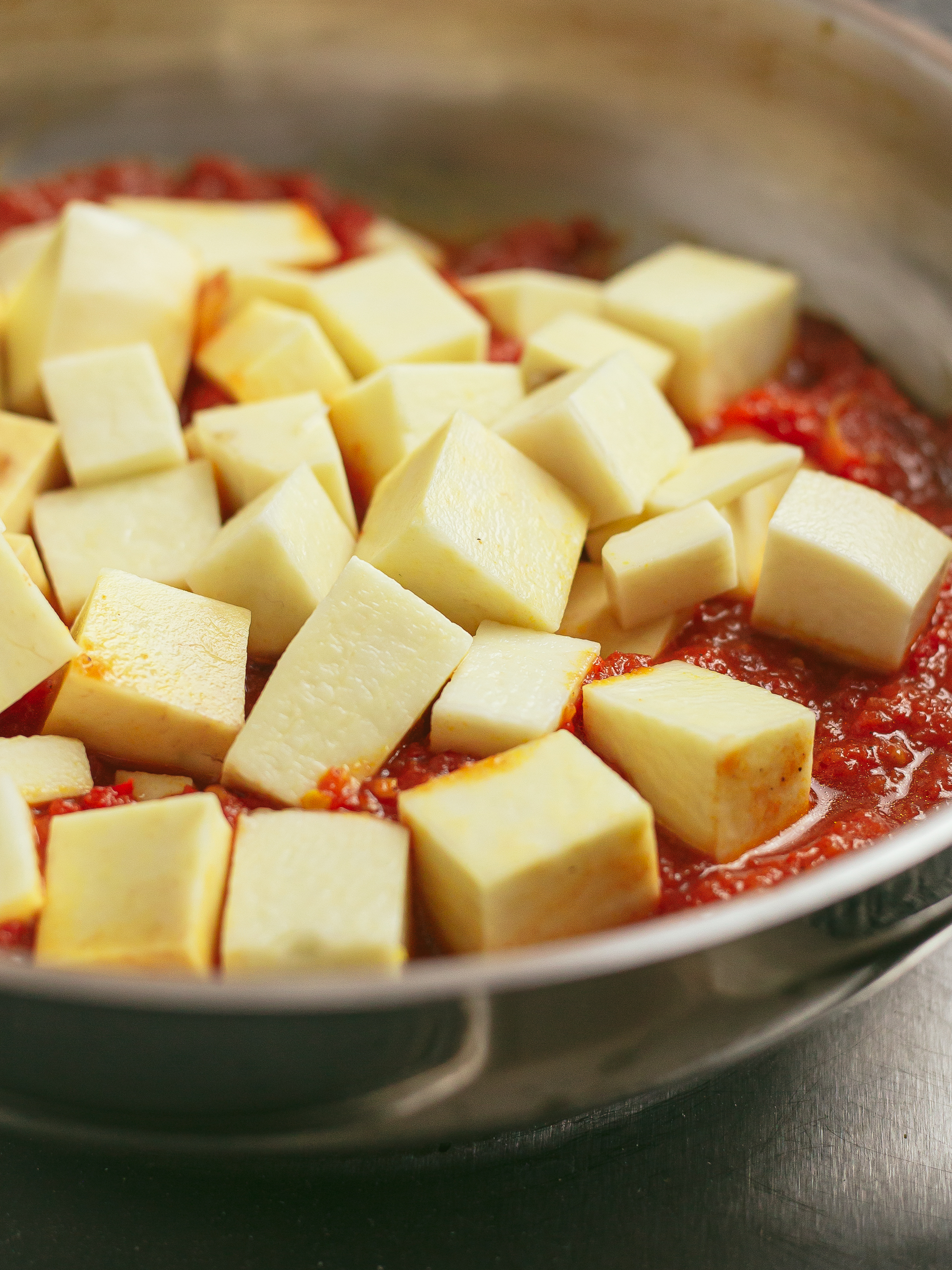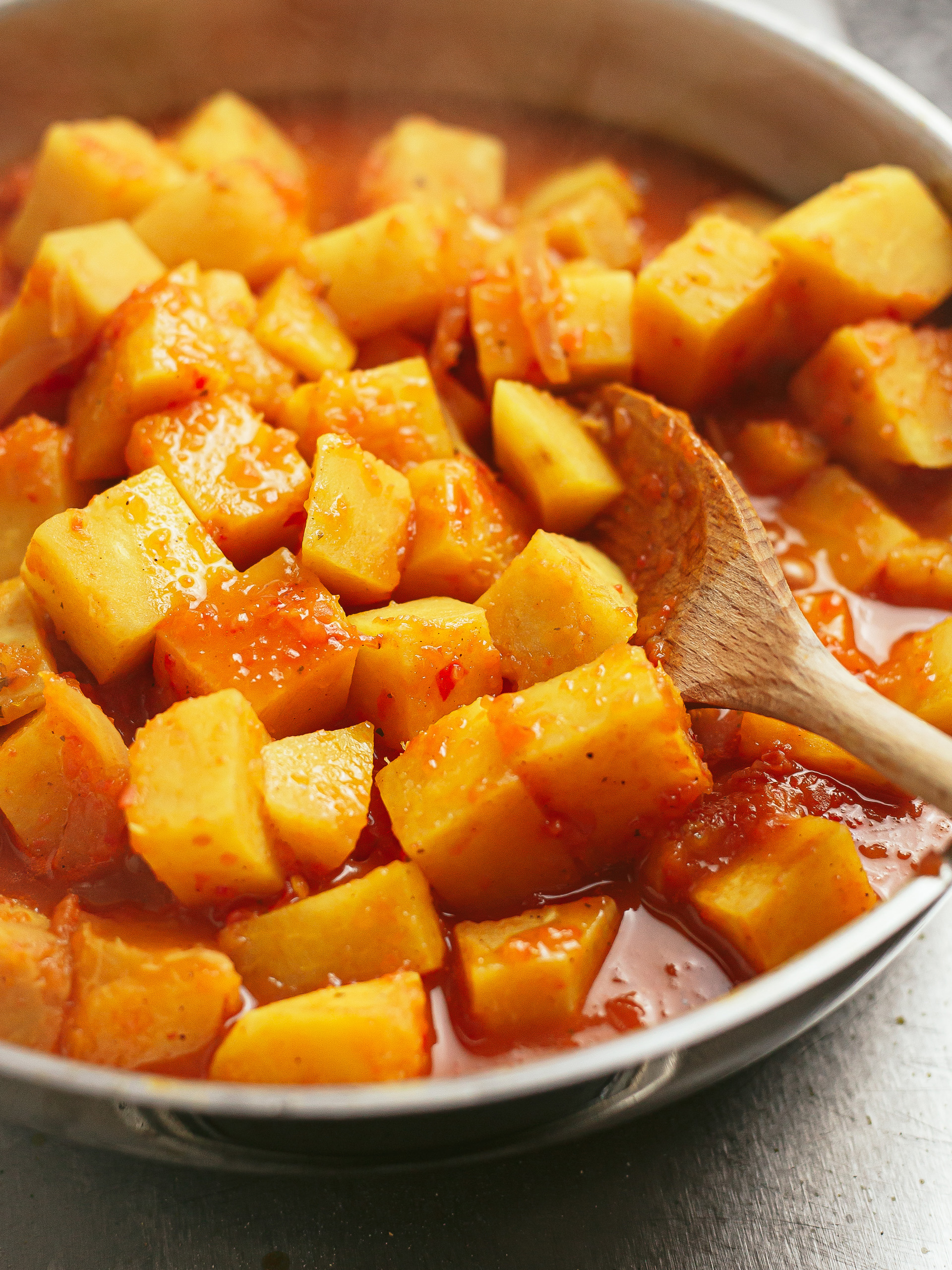Yam pottage or asaro is a traditional vegetable dish from Nigeria where chunks of yam are simmered in a spicy tomato broth until mashy.
This delicious African stew, also known as yam porridge, is hearty and saucy with the satisfying creaminess of starchy white yams.
Today, we'll show you how to prepare Nigerian yam pottage using easy-to-find ingredients so you can make it even if you don't have access to an African food market.
The recipe for asaro starts with a sauce of blended red peppers, tomatoes, onions and scotch bonnets or habanero chillies.
This base puree is typically sizzled in red palm oil, but we swapped it with healthier extra virgin olive oil and added turmeric for colour.
Diced white yams are then added to this base spicy sauce and cooked in vegetable stock until soft to make a thick stew.
Finally, yam porridge is traditionally rounded up with greens like amaranth or pumpkin leaves plus African scent leaves, which we replaced with spinach, sweet basil, and ground cloves.
Packed with nutritious vegetables, this Nigerian-style yam porridge makes a healthy side dish, low in fats and high in fibre.
And it's perfect for accompanying a nice African bean stew, seasoned rice, and eggs or meats.
You'll find lots of tasty pairing ideas in the FAQ section!
What’s yam pottage?
Yam pottage or yam porridge is a popular Nigerian stew prepared with yam, a starchy tuber that’s boiled until soft and slightly mushy.
African pottage is known locally as asaro, a traditional dish originating from the Yoruba people of Nigeria.
The word pottage is an Old French term that refers to a thick soup made by slowly boiling ingredients like vegetables, grains, or meat in a little liquid.
Which are the ingredients for yam porridge?
The main ingredients of African yam stew are white yams, onions, red peppers, tomatoes, and red palm oil.
Some asaro recipes also include aromatic herbs and greens, like scent leaves, amaranth, and fluted pumpkin leaves (ugwu/ugu).
Is yam pottage vegetarian?
In its most basic recipe, Nigerian yam pottage is a vegetable dish with yams, tomatoes and peppers, so it’s suitable for vegetarians and vegans.
However, in some regions of Nigeria, ingredients like crayfish, smoked fish, prawns, fish stock, goat meat and cow tripe can be added for extra flavour.
Can you make Nigerian asaro without palm oil?
Red palm oil is an essential ingredient in the traditional Nigerian recipe as it gives the yam stew a characteristic red-orange hue and nutty flavour.
If you want to prepare yam porridge without red palm oil, swap it with vegetable oil and add a little turmeric and tomato paste to get a similar hue and flavour.
In our recipe, we used extra virgin olive oil: this heart-healthy oil comes with less than half the amount of saturated fat as red palm oil, making it a healthier alternative.
Do you need scent leaves to make yam porridge?
Also called African basil or clove basil, scent leaves are a sweet, aromatic herb often used in yam pottage.
You can prepare yam pottage without scent leaves, replacing them with Thai or Italian basil plus a fragrant spice like nutmeg, fennel, or clove — just as we did in our recipe here.
Which greens are used in African yam pottage?
Greens like amaranth and pumpkin leaves (ugu) are often added to the yam stew toward the end of cooking.
If you can’t find them, you can easily replace them with fresh spinach, kale, collard greens or mustard greens — or whatever leafy green is local to you.
What do you eat yam porridge with?
You can enjoy yam porridge as a main or side dish, pairing it with seasoned rice, spinach stew, bread, and fried plantains, but also boiled eggs, grilled fish, and meat stew.
Here are some tasty African recipe ideas that go well with yam porridge:
Ingredients
| Red Bell Peppers | 2 |
| Habanero/Scotch Bonnet Chillies | 2 |
| Large Tomatoes | 2 |
| Tomato Puree | 1 tbsp |
| Red Onion | 1 |
| Ground Turmeric | 1/2 tsp |
| Ground Cloves | 1/2 tsp |
| Extra Virgin Olive Oil | 2 tbsp |
| White Yam | 800 g |
| Vegetable Stock | 650 mL |
| Fresh Spinach | 160 g |
| Fresh Basil (chopped) | 2 tbsp |
Step 1
Add red bell peppers, chillies, tomatoes, tomato paste, half of the onion, turmeric, and cloves to a blender (1).
For better digestibility, you can peel the peppers' skin with a vegetable peeler or a knife.
For less spiciness, remove the seeds and ribs of the Scotch bonnet chillies or use half the chillies.
Then, blitz all the ingredients into a spicy tomato sauce (2).


Step 2
Heat the olive oil in a pan and fry the remaining onions until soft and fragrant.
Then, add in the pepper tomato sauce and cook it for 5 minutes, stirring occasionally.

Step 3
Peel the yam, dice it into chunks and rinse them a couple of times under running water.
Add the yam to the spicy tomato sauce and stir well.

Step 4
Now, pour in the stock, bring to a boil, and simmer the yam stew for 20 minutes.
Once most of the stock has reduced and the yam is cooked through, the yam will be soft enough to start flaking off and falling apart.
At this point, you can either mash the yam chunks with a fork/masher to get a creamier texture (like a porridge) or leave the stew chunkier — it's up to you.
If when mashed the yam stew gets too dry, just add a splash of stock and stir well.

Step 5
Finally, stir in chopped spinach and basil and cook until just wilted (1).
Your Nigerian vegetable yam pottage is ready!
Serve it warm on its own or alongside rice, beans, or boiled eggs to make it a complete meal (2).


Tips
Nigerian yam porridge is often served with dried fish as a topping. To get a similar flavour, you can add a couple of mushrooms to the simmering stock if you like or sprinkle the stew with nutritional yeast flakes.
You can replace cloves with allspice or fennel.
For a richer yam stew, add half a can of light coconut milk to the simmering broth.
